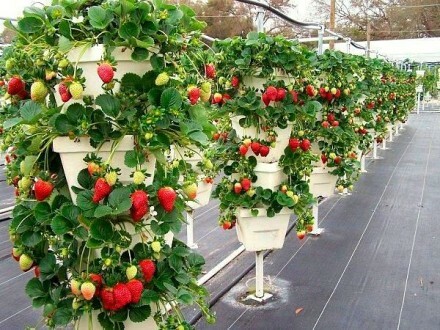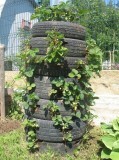Gardeners know that it is necessary to divert a large part of strawberriescountry plot. In addition, it takes a lot of effort not only during the processing of bushes, but also when harvesting. To save space and energy, you can arrange on the site special beds for the vertical planting of berry bushes. About how to plant a strawberry vertically, we will tell in this article.
Advantages and disadvantages of the vertical method
The original way of planting strawberries is of interest to many gardeners. Before you start building such beds, you should evaluate all their advantages and disadvantages.
The advantages of vertical beds
- The
 is liberated for significant areas for other landings.
is liberated for significant areas for other landings. - Berries grown on vertical beds, do not have contact with the ground. Therefore, they are not affected by gray rot in rainy weather and remain clean.
- Before the harvest, small pests, for example, rodents, can not be reached.
- Vertical beds do not require weeding.
- The harvesting process is much easier.
- Vertical plantings have decorative value. They can be used to decorate a cottage, a fence or a garden gazebo.
Cons
- Strawberries growing on vertical beds should be fed at least 1 time per week.
- With the onset of cold weather, the vertical structure must be disassembled and carried to a closed room. Otherwise, the ground in it will freeze to the ground.
- Plants on vertical beds need frequent watering, as the ground under them very quickly dries up.
Selection of variety
You can grow any strawberry in a vertical way. But best for this purpose fit ampelnye, that is, cascading or climbing varieties. In addition, it is worth opting for a patchwork strawberry that forms a mustache. It will bear fruit until the fall. In this case, the fruits are formed not only on the uterine bush, but also on the antennae.

Consider in more detail the most popular varieties.
- Alba is a yielding early variety. The berries are bright red and very dense and juicy pulp. The main advantage of the variety is resistance to low temperatures.
- Homemade delicacy - an early remontant strawberry, which is used in ornamental horticulture. On long peduncles ripen sweet and sour berries of medium size, painted in a rich red color.
- Ostara is a variety bred by Dutch breeders especially for ampel cultivation. Has a compact shrub with dark green leaves and small in size, but very juicy sweet and sour berries. It does not cease to bear fruit even with the onset of autumn.
- Geneva is one of the most undemanding to care varieties. The bush has long flower stems of a paniculate type, on which large fruits with dense flesh grow.

- Aluba is one of the most large-scale repair types that are suitable for vertical planting. The berries are very dense and sweet, they tolerate transportation well.
Structures for vertical planting of strawberries
Various materials are used for making vertical structures:
- bags of dense polyethylene;
- plastic water pipes or sewer pipes;
- old car disks and tires;
- plastic bottles;
- pots with staggered cells-nests;
- drums;



- slate;
- wooden boxes of rectangular shape;
- metal pallets;
- boards;
- metal mesh.
Let us dwell in detail on some constructions for growing strawberries vertically.
- Pipe. This kind of vertical bed is the most popular. From one four-meter tube, 2 beds are obtained, which will be handled conveniently.

- The design consists of a wide tube, in which staggered holes are made for planting. The distance between the holes should be 20 cm. The lower one is at a height of 50 cm from the ground. The base of the pipe is closed by a plug with drain holes and digs into the ground.
- A longer and thinner tube of metal-plastic is placed inside the wide pipe. It is wrapped in fabric and wrapped in a string. The lower part of the pipe is tightly closed, and above it holes are made that allow the water to be evenly distributed in the soil. The pipe, filled with soil, is ready for planting. If there is no possibility to make such a bed independently, it can be purchased at a specialized store.
- Multi-storey
 suspended beds. Such structures are made of plastic pipes or bottles, cut in two along the length. They are assembled with ropes that hold tiers. Such a bed can be hung in any corner of the garden or attached to the wall of the house with the help of hooks.
suspended beds. Such structures are made of plastic pipes or bottles, cut in two along the length. They are assembled with ropes that hold tiers. Such a bed can be hung in any corner of the garden or attached to the wall of the house with the help of hooks. - Pyramid. This is the simplest version of the vertical bed. It consists of several containers of different sizes, which are stacked on top of each other. Various materials are used to construct the pyramid.
- Beds from automobile tires. This kind is simple in manufacturing, but has a significant drawback: the material from which tires are made is toxic. For this reason, such designs are best used only for decorative purposes.
- Construction of metal pallets or boards. The product is environmentally friendly and durable. But this bed has a significant disadvantage: it will be difficult to disassemble in the fall, to be transferred to the shelter.
- Constructed from flower pots. Pots of different diameters are stacked on each other, forming a cascade. If you decide how beautifully to plant strawberries on the plot, ceramic flower pots will do just fine. The disadvantage of this bed is that it is unlikely to make it above 1 meter.


- For the vertical planting of strawberries, old furniture, for example, a chest of drawers with drawers, is also suitable. If you put them on different levels, you get a kind of "half-pyramid", which will be easily dismantled at the right time.
Soil preparation
For planting, choose a well-lit place that will not be blown by the wind. In addition, the vertical bed requires special filling.
Drainage is placed in its base at a height of 10-15 cm. For this purpose, pebbles, gravel or gravel are suitable. Further, the container is filled with a mixture of different components in the following ratio:
- 20% manure;
- 30% of mature compost;
- 25% of turf;
- 25% peat.

Planting of
- In the spring, when the strawberry starts to bloom, from the most powerful bushes we pinch 1-2 tendrils and transplant them to a new bed.
- To protect seedlings from pests, plant roots are left for a few hours in a weak solution of potassium permanganate.
- To get a better strawberry, before planting the roots dipped in a clay popper.
- During the transplant, one should try not to fill the central kidney with earth. The landing should be mulched so that the soil will remain moist for longer.
- In the first week seedlings need to be watered in small portions 2 or 3 times a day. After two weeks, watering can be reduced to 1 time in three days.
- As soon as flowers appear on young plants, they should be removed.
- After 2 weeks, you can spend the first fertilizing of young plants.
- Strawberries, grown vertically, can grow in one place for no more than 2-3 years. After that, it needs to be transplanted.
Strawberries on vertical beds of pipes - video
Care
- Watering for vertical plantations is an essential element of plant care. Since the strawberry does not get moisture from the lower layers of the soil, water must be constantly supplied from outside. The optimal watering schedule for such plantings is 1 time per 3 days. But if you can not visit the site more than once a week, you can use hydrogel, pipes with holes or drip irrigation.
- Hydrogel - small balls that absorb water well. They are added to the soil, and during watering they are immersed in moisture. Gradually, the balls emit water, which enters the plants.
- Thin plastic pipes are used to keep the soil wet in bedrock-pipes. Watering is done through the upper opening, the water from which enters the soil through the holes drilled in the pipe.
- Drip irrigation allows you to dose water to every level of the bed.

- Feeding. Strawberries on vertical beds need regular feeding. They are carried out once in 7 days with liquid fertilizers.
- It is necessary to cut off unnecessary mustaches from plants. On one bush there should be no more than 5 pieces.
- When fruiting is over, all foliage should be removed to rejuvenate the bushes.
Preparation of beds for the winter period
Before the onset of cold weather, vertical structures are usually removed to a closed room. Otherwise, the land in them is likely to freeze and the plants will die.
Diseases and pests of ampelberry strawberry
Although growing strawberries on vertical beds protects it from more damage, nevertheless some diseases and pests still affect berries.
- White and brown spot.

- White spotting affects the leaves of the plant. They appear patches of burgundy and brown, which, gradually increasing in size, acquire a white color in the center. After a while, the white part of the leaf disappears.
- A brown spot also appears on the leaves. They are almost completely colored brown, and then die, which affects the future harvest.
To prevent the occurrence of diseases, a number of preventive measures should be taken.
- In spring, clean the strawberries from the old foliage.
- Treat bushes with Bordeaux fluid. Before flowering - a three-percentage solution, and after harvesting the last crop - one-percent.
- Powdery mildew is a white plaque that appears on stems and leaves, and on berries. At the same time the leaves turn yellow and turn into a tube, and the fruits rot. To prevent disease, the bushes before flowering and in autumn they spray with a solution of sulphuride, 2 tablespoons of which are bred in 10 liters of water. In addition, at the beginning of spring strawberries are treated with a solution of potassium permanganate. For 10 liters of water take 1.5 g of powder.


- Strawberry mite affects young leaves. They turn yellow and curl. Plants afflicted with mites grow poorly and yield a poor harvest. Carbophos helps against the pest. They spray the bushes after picking berries and cover them with polyethylene for 2 hours. With severely damaged plantings, after spraying, the leaves are removed. Pruning should be carried out no later than mid-August, so that fresh foliage could grow up to the first frosts.
- If the beds are located in the shade or the soil under the plants is too moistened, then the fruit can damage the centipedes. For each square meter of the landing area it will require 3 grams.To protect the crop from these insects, the bushes are treated with methylaldehyde prior to the beginning of vegetation.
- Weevil and its larvae eat leaves and buds of strawberries. To control the pest, use carbofos or special preparations, for example: "Iskra" or "Confidor".Video on the topic: The vertical way of growing strawberries. Growing strawberries.
 9:22 Strawberries on vertical beds - trudniks
9:22 Strawberries on vertical beds - trudniks 1:04 Vertical beds
1:04 Vertical beds
